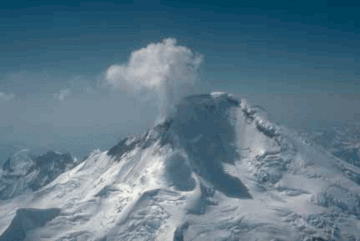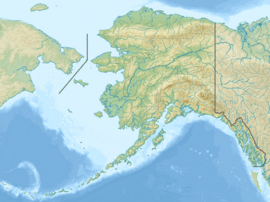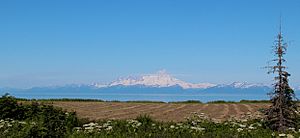Mount Iliamna facts for kids
Quick facts for kids Mount Iliamna |
|
|---|---|

View of the glaciated north flank of Iliamna Volcano. A plume of steam and gas typically rises several hundred meters above the fumarole field.
|
|
| Highest point | |
| Elevation | 10,016 ft (3,053 m) |
| Prominence | 7,867 ft (2,398 m) |
| Listing |
|
| Geography | |
| Location | Lake Clark National Park and Preserve, Kenai Peninsula Borough, Alaska, US |
| Parent range | Chigmit Mountains, Aleutian Range |
| Topo map | USGS Lake Clark A-1 |
| Geology | |
| Mountain type | Stratovolcano |
| Volcanic arc/belt | Aleutian Arc |
| Last eruption | 1876 |
| Climbing | |
| First ascent | 1959 |
| Designated: | 1976 |
Mount Iliamna, known as Ch’naqał’in in the Denaʼina language, is a large volcano covered in glaciers. It is part of the Aleutian Range in southwest Alaska. This tall, cone-shaped volcano is found in the Chigmit Mountain area, inside Lake Clark National Park and Preserve. Mount Iliamna stands about 10,016-foot (3,053 m) (3,053 meters) tall. It is located roughly 134 miles (215 km) (134 miles) southwest of Anchorage, on the western side of the lower Cook Inlet. It is one of the most noticeable peaks in the United States.
Contents
How Glaciers Shaped the Volcano
The many glaciers on Mount Iliamna have greatly changed its shape over time. They have carved deep valleys and created steep cliffs and bowl-shaped hollows called cirques. A long ridge stretches about 5 kilometres (3.1 mi) (3 miles) south from the main part of the mountain. Along this ridge are two smaller peaks, North Twin and South Twin.
Mount Iliamna does not have a typical crater at its top. Instead, there is an area with fumaroles just south of the summit. Fumaroles are vents that release steam and gases from inside the volcano. This area is at the top of a large collapse zone, which is like a big hole in the mountain. This collapse zone shows a cross-section of the mountain's inside.
Volcanic Activity and Eruptions
Scientists do not know much about the recent eruptions of Mount Iliamna. However, using radiocarbon dating, they have found evidence of a few eruptions that happened before Europeans settled in Alaska.
Some of the past eruptions include:
- Around 5050 BCE and 2050 BCE (these were large eruptions, rated VEI 4)
- Around 450 BCE
- In 1650
- In 1867 (a smaller eruption, VEI 2)
- In 1876 (a medium eruption, VEI 3)
Fumaroles on the eastern side of the volcano, at about 8,990 feet (2,740 m) (9,000 feet) high, constantly release plumes of steam and small amounts of sulfur gases. These plumes are quite strong. Because of them, many pilots and early explorers thought the volcano was erupting.
Scientists also noticed more earthquakes and gas coming out from the volcano in 1996-97 and again in 2011–13. The U.S. Geological Survey has ranked Iliamna as a high-threat volcano. In 2018, it was ranked as the 20th most dangerous volcano in the United States. This means it poses a significant risk, especially for airplanes flying nearby.
Glaciers of Iliamna
Several large glaciers are found on Mount Iliamna. These include:
- Red Glacier
- Tuxedni Glacier
- Lateral Glacier
- Umbrella Glacier
First Ascent and Landmark Status
The first time anyone successfully climbed Mount Iliamna was in 1959. Later, in 1976, it was named a National Natural Landmark. This means it is a special natural area recognized for its outstanding geological features.
See also
 In Spanish: Monte Iliamna para niños
In Spanish: Monte Iliamna para niños



